
BMW M5
Generations Timeline, Specs and Pictures
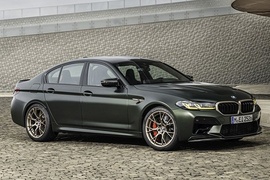
BMW M relentlessly tried to make its cars quicker and faster than its competitors, and the CS versions were even wilder.
When you lock a car-maniac into its room due to a world pandemic situation, all they had to do was think about how to make a car faster. Maybe exactly that happened to the BMW M engineers, who had to work from home in the infamous year 2020. Unlike the rest of us, who wore out the TV remote controller and made a new couch to look like it was older than the house itself, they prepared an outrageous vehicle: the M5 CS.
Forget about the heavy, regular M5 (which was already a fast car) and look at the front, yellow, daytime running lights. We would name them “angel eyes” like anyone else, but we are afraid not to be banned forever from Heaven. They looked from the dark side. The grille was not tall, like on the M4, but shorter and above the sculptured bumpers that sported a lower grille and two side-scoops (functional). A carbon-fiber splitter helped to reduce the ground effect at higher speeds. BMW M made the hood and other parts from carbon-fiber-reinforced plastic (CFRP). Some elements were left unpainted. Why bother? They looked better that way. Through the standard, 20” light-alloy-wheels, the car sported the red calipers.
Inside, the carmaker dropped the 5-seat option and installed four M Carbon sport-bucket seats. At the front, the integrated headrests sported illuminated M5 logos and displayed the outline of the Nurburgring race-track. Behind the steering wheel, the engineers installed two carbon-fiber paddle-shifters for the 8-speed automatic M Steptronic gearbox. Inside the instrument cluster, there was no dial or gauge: just a wide digital customizable display.
Under the hood, M engineers dropped the most powerful engine ever installed in a BMW. The 4.4-liter twin-turbo V8 provided 635 hp, which were sent in all corners. Like its non-CS brother, it was able to send all the torque to the rear wheels for spectacular drifts.
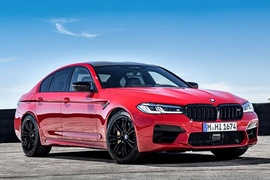
BMW introduced the sixth generation of the M5 in 2017, and it was the first M5 available with an all-wheel-drive system.
It was available with the Competition package, and it was refreshed in 2020.
BMW introduced the strongest letter in the alphabet, the M, in 1977 with the mighty supercar BMW M1. After the introduction of the M3 – E30 in the mid-’80s, the German car-maker started a new era in automotive trend. The horsepower battle began for family sedans with the first M5 and it never stopped.
The Competition package took the M5 design to a different level with black styling on the grille surrounding. The door-mirrors caps and the rear spoiler featured the same color. The rear LED taillights received a new design and the twin-tailpipes featured thinner walls, for a better sound.
Inside, the M5 featured a complete digital display for the instrument cluster, and for the infotainment system, the latter sat on top of the center stack. The gear-selector was placed on the center console, surrounded by glossy-black trims. Since the car was built for high-speed driving and hard cornering, the front bucket seats supported the occupants due to the high bolstering.
The M5 Competition package squeezed 25 hp more from the regular M5 engine. It unleashed the 625 hp to all four wheels via an 8-speed automatic transmission. The traction system’s different settings allowed the driver to send all the power to the rear wheels and disengage the dynamic traction control for drifting. And, if the 250 kph (155 mph) speed was not enough, the M Driver package option raised the bar to 305 kph (189 mph).
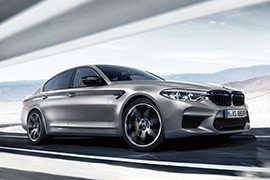
One of the best sports sedan on the market, the BMW M5 was a 4-door 5-seater sedan.
While the M5 had all the luxury of a BMW 5-Series, its sports nature was revealed by the fierce turbocharged V8 engine. The powerplant produced 600 hp and 553 pound-feet of torque and was mated with an 8-speed automatic transmission.
New for the M5, the sedan had an all-whee-drive system that was previously used with the X5 M and the X6 M.
The new M5 was equipped with an improved suspension and a more precise steering, although, some users may find the car a little bit too stiff for daily driving.
Available with only one version, the M5 features 19-inch wheels, adaptive LED headlights, a head-up display, heated steering wheel as well as heated seats and a 10.2-inch touchscreen display. The audio system was a 16-speaker Harman Kardon.
Safety wasn’t left aside and BMW equipped with M5 with front and rear parking sensors, a lane departure warning system, blind-spot detection and front collision mitigation.
Two option packages were available, the Driving Assistance Plus and the Executive. While first one provided even more safety features, the Executive was more designed to offer premium comfort with ventilated and massaging front seats, heated rear seats, soft-close doors, automatic parking and others.
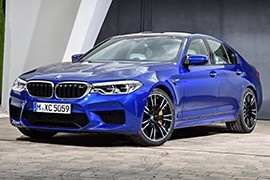
A whole new BMW M5 was introduced in the summer of 2017, marking the sixth generation of the high performance sedan and taking BMW M GmbH into new territory thanks to the use of M xDrive for the first time.
This change of tack sees the M5 exploring new dynamic dimensions and offering greater everyday practicality in all driving conditions.
Providing ample power for the new BMW M5 is a 4.4-litre V8 bi-turbo engine with M TwinPower Turbo technology. The M engineers have carried out significant revisions to the outgoing model’s power unit. For example, newly developed turbochargers, ultra-efficient indirect charge air cooling and increased fuel injection pressure together help to raise output and, above all, torque. The suspension of the new BMW M5 is likewise designed to deliver both maximum traction for everyday use and supreme dynamic performance on the track.
Visually, the M engineers have redesigned the broader front side panels and front bumper trim to include larger apertures for the air feeding the cooling systems and brakes. Also new is the rear diffuser. The exhaust system’s quartet of tailpipes are a visual pointer to the power generated by the BMW M5 and also lay on a suitably sporting soundtrack for the job in hand, courtesy of their flap control system. The driver can use a button to adjust the engine sound as desired.

The fifth generation of the M5 was launched in 2013 and was the first time in its history when it dropped the engine displacement.
But with the addition of twin-turbo twin-scroll turbochargers, the power and torque were increased.
The M5 always had the nickname of the “autobahn sleeper”. All the previous M5s had subtle changes compared to the rest of the 5 series models. That habit was maintained in the 2013 model. The only changes are made to the front where a larger bumper with three big air intakes and honeycomb mesh is present. The kidneys are rounded by a chromed rim and on the front side fenders, there is ventilation grille. The side sills are a little bit bigger than of the other models.
In the rear, a quad exhaust, bigger rear bumper and a small spoiler on the trunk lid will tell the others that they were just overtaken by an M5. But this kind of modification is noticeable only by a car enthusiast.
The interior features enough luxury items to be considered a limousine. The standard list is long and includes bolstered seats, power-adjustable steering column, backup and front-side cameras. The interior space is enough for five people. But the center driveshaft tunnel is tall enough so only two passengers can sit comfortably in the rear.

Fifth generation of the world’s most successful high-performance sedan in the premium segment of the executive class; new BMW M5 is an exceptionally dynamic high-performance sports car with four doors and five seats; consistent further development of the vehicle concept initiated in 1984 with the first-generation BMW M5; compelling track potential combines with the comprehensive practicality of a luxurious business sedan; groundbreaking character headlined by significantly improved efficiency, supreme long-distance comfort, and innovative driver assistance systems and infotainment functions.
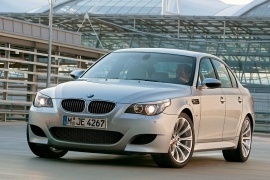
With a design that sparked many controversies, the fifth-5 Series from BMW shook the world when it was launched in 2003.
Then, two years later, the top-performer M5 stormed the performance-sedan market with its F1-inspired powerplant.
While its previous M5 versions were more subtle in terms of design, compared with their less-powered 5 Series siblings, the 2005 model was more daring. It sported an aggressive styling for the front bumper with a wide, V-shaped lower grille flanked on the sides by functional scoops needed to cool the brakes. On the front fenders, the carmaker installed a pair of vents with M5 badging. Its unique, 19”, 10-spoke light-alloy wheels gave the car a sportier look. From the back, a quad-exhaust system warned the bystanders that this was not regular 5 Series.
The carmaker installed all the goodies it had on the storage on the interior, such as high-bolstered seats at the front and a wide center console fitted with the iDrive infotainment controller. The leather upholstery covered the seats, the bench, the door panels, and the front center armrest. For the dashboard, the design team imagined a two-cluster design, with the one in the middle for the infotainment unit while the one in front of the driver was for the dials and gauges.
Under the hood, BMW installed a Formula 1-inspired V10 powerplant. It provided 400 hp on regular driving modes and up to 507 while in M-mode. It paired it to a standard seven-speed automatic (SMG) transmission. On the US market a six-speed manual was available as an option.
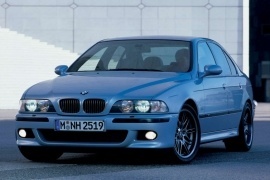
BMW launched the third generation M5 at the 1998 Geneva Motor Show.
Aimed to challenge the new Jaguar XJR and Mercedes-Benz W210 E55 on the premium-sport sector, the new M5 showed up with a newly-developed 4.9L V8 engine delivering 400 hp and 369 lb-ft of torque. Throughout its 6 years of production, the M5 received several new features (on a year-to-year basis) including revised headlight-design, new front bumper or rear-head airbags. When launched, the new BMW M5 was the powerful 4-door saloon car in the world, scoring an impressive 5.3 seconds on the 0-60 mph sprint and topping 178 mph (although it was electronically limited to 155 mph).

The first M5 was introduced on the first-generation very late, when the car was almost out of production line.
For the second generation though, BMW decided to offer it from the start.
The battle for the sport-sedan market had begun when the BMW M3 and the Mercedes-Benz 190 2.5-16 started to compete against each other on the track of the DTM races. That also started a competition on the sales floor where both manufacturers succeeded to gain respect and appreciation from their customers. Customers who noticed that fast and luxurious could fit in the same vehicle.
The production of the second generation of the BMW 5-Series started in 1987, but it was launched at the beginning of the following year. In September 1988, the M-version was ready to meet its customers. The E34 M5 was not very striking. It looked more like a regular 5-Series with different wheels and slightly different bumpers and sills. That was the idea: to offer a performance vehicle that looked just like a regular one.
Inside there was a different story. Its front seats were bucket-type and offered good lateral support on cornering. The M-letter along with its three light-blue, dark-blue, and red lines on the dashboard. The electrically adjustable steering column was a rare feature on the market. On the center console, there was a trip-computer that looked weird with a lot of buttons and a small, LED, screen.
The magic was under the hood where a naturally aspirated 6-cylinder was installed. The M5 was offered with a 3.5-liter between 1988 and 1991. After that, a 3.8-liter unit was installed. These engines offered 315 hp and 340 hp, respectively. It was mated to a standard 5-speed manual up to 1994. The 6-speed manual was offered only for a year.

The first generation of the BMW M5 came out on the market in 1985 and its main weapon was highly concealed under a bodywork that looked the same as on a basic 5-Series with nicer wheels.
By the time when the second generation of the BMW 5-Series was launched, the whole company design language was established, with the shark-nose profile for the whole range. The first vehicle which featured that front profile was the 7-Series and it was followed by the 6-series. The development for the second generation started in 1985 and it involved the spare-parts department and the accounting computer. It was the only computer in the company.
The E28 5 Series was launched in 1981 and it was a simple, four-door sedan. It was meant to be a car for the premium customers, with decent performance and better handling than the competition, mainly the Mercedes-Benz. In 1984, the M 535 I was launched, and it was a commercial success with its 218 hp engine. But that was not all. The four-door sedan was improved once again in 1985 with the first, true, M5. It featured the M88/3 engine, which was used on the 3.0 CSL race-car and in the famous BMW M1. The twin-cam, 24 valves unit offered 286 hp and that was only a part of what the M5 could offer. A 5-speed manual transmission was the only option.
From the outside, only a few clues would tell the difference. There were a special bumper, side-sills, and a rear deck-spoiler. On the grille, a small M5 badge was installed as well as in the rear. Special BBS light-alloy wheels were standard for the top-model. At the time of the launch, it was the fastest 4-door sedan in the world.

The M 535i was the first road car produced by the BMW Motorsport GmbH and launched in 1979 as a high-performance sedan and started the horsepower competition.
While the M1 was produced in a limited number to promote the new badge and eventually became a legend, the M 535i was a regular sedan with more power than any other BMW production vehicle. It had the heart of a race-car, a tuned suspension and a few bodywork enhancements.
The first 5-Series was part of the BMW range since 1972, and it was already a common view on the streets. Paul Bracq signed the car’s design and imagined that raked forward front fascia making the car looks like a shark. But when he had to adjust the M version, he added an apron with vents under the bumper. From its sides, the M 535i sported a set of magnesium wheels, unique for that version. In the back, the carmaker added a lip-spoiler on the trunk to create some downforce on the rear axle.
Inside, Motorsport GmbH installed sport bucket-seats provided by Recaro with high bolstering for the front passengers. The dashboard was similar to the rest of the range, with the tilted toward driver center stack and a clock on top of it. Inside the instrument cluster, the M 535i sported wide dials for the tachometer and speedometer and two smaller gauges for the fuel level and coolant temperature.
But the real transformation took place hidden under the bodywork. The carmaker installed a 3.5-liter, inline-six engine that produced 218 hp thanks to its injection system. It was paired as standard to a five-speed manual. The suspension was stiffened to ensure a higher cornering speed than its siblings. BMW produced only 1400 units of it between 1979 and 1981.























































